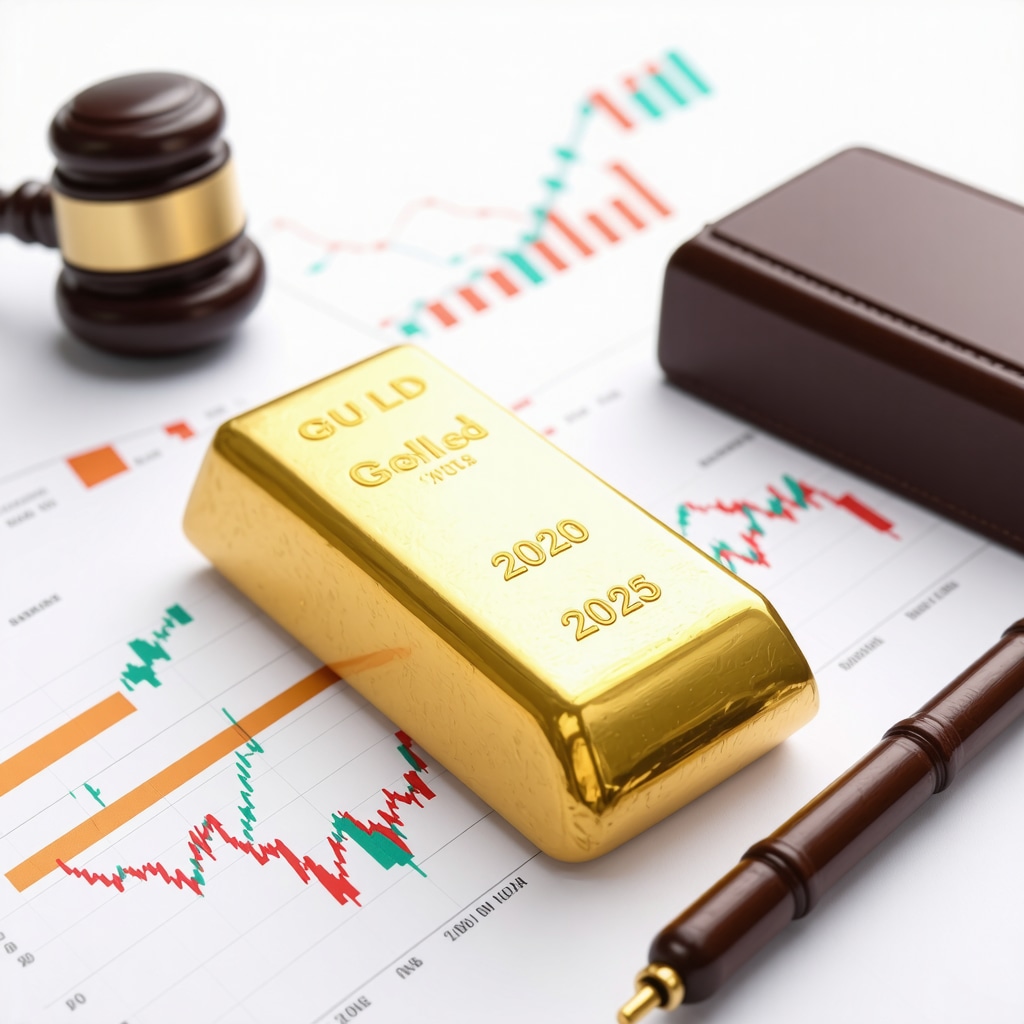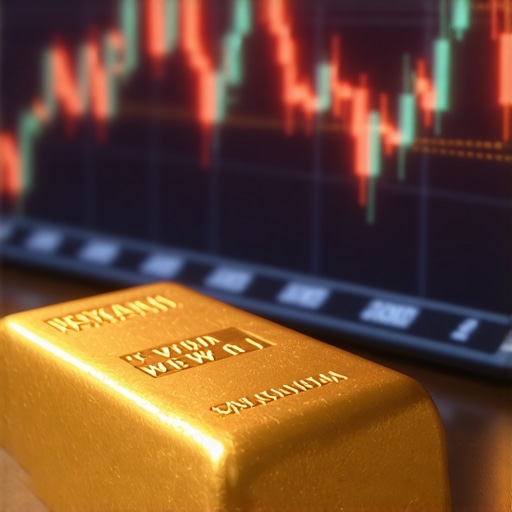Understanding the Complex Interplay of Economics and Politics in Shaping Gold Prices in 2025
As a seasoned analyst in commodity markets, I recognize that the year 2025 presents a unique convergence of economic and political factors influencing gold prices. In an era marked by geopolitical shifts and macroeconomic adjustments, gold remains a vital barometer of financial stability and investor sentiment. This article delves into the nuanced drivers behind gold price fluctuations and offers expert insights into navigating this volatile landscape.
The Role of Macroeconomic Policies in Gold Valuation
One of the primary economic drivers in 2025 is the evolving landscape of monetary policy, especially central banks’ approach to gold reserves and interest rates. As detailed in the white paper on central bank gold purchases, increased accumulation of gold by central banks serves as a hedge against inflation and currency devaluation. This strategic move influences gold’s safe-haven appeal, especially amid inflationary pressures stemming from expansive fiscal policies and supply chain disruptions.
Geopolitical Tensions and Their Impact on Gold Dynamics
Political instability and international conflicts significantly contribute to gold’s price trajectory. Tensions between major powers, trade disputes, and regional conflicts tend to elevate gold as a refuge asset. The uncertainty surrounding geopolitical developments prompts investors to seek security, driving demand and elevating prices. Analyzing recent trends, it becomes evident that such tensions in 2025 are intertwined with economic sanctions and shifting alliances, amplifying gold’s strategic importance in diversified portfolios.
What Are the Experts Saying About Gold Price Forecasts for 2025?
Market forecasts predict a nuanced trajectory for gold, balancing inflation concerns with potential monetary tightening. According to market experts’ predictions, gold could see moderate appreciation if inflation persists and geopolitical risks escalate. Conversely, any signs of stabilization in global markets might temper gains. This complex outlook underscores the importance of strategic gold investment and active portfolio management.
How Can Investors Leverage Political and Economic Signals to Optimize Gold Trading in 2025?
Proactive investors should monitor policy shifts, geopolitical events, and macroeconomic indicators closely. Techniques such as technical analysis combined with fundamental insights into policy changes can inform timing and position sizing. For detailed strategies, explore effective gold trading techniques. Staying informed about central bank policies, inflation rates, and international conflicts enhances decision-making precision, essential for thriving in the 2025 gold market.
For comprehensive insights, consider exploring gold stocks and mining shares as alternative exposure strategies, or delve into demand trends that influence physical gold markets.
Decoding the Impact of Global Economic Shifts on Gold Prices in 2025
As we navigate through 2025, understanding the intricate relationship between macroeconomic policies and gold valuation becomes crucial. Central banks’ strategies, especially their gold reserve management, play a pivotal role. According to the white paper on central bank gold purchases, increased accumulation of gold by these institutions signals a strategic hedge against persistent inflation and currency devaluation, directly influencing gold’s safe-haven status.
The Geopolitical Landscape and Its Strategic Influence on Gold
Political tensions, regional conflicts, and international trade disputes continue to shape gold’s price trajectory. Heightened geopolitical risks tend to push investors toward gold as a secure asset, resulting in price surges. Recent developments in 2025 highlight the importance of geopolitical awareness. For a comprehensive understanding of how these dynamics influence physical gold markets, explore demand trends and market opportunities.
Can Gold Be Your Best Hedge Against Inflation in 2025?
Expert forecasts suggest that gold’s effectiveness as an inflation hedge remains robust, especially amid expansive fiscal policies and supply chain disruptions. As detailed in the comprehensive guide to gold demand trends, investors should consider integrating physical gold, such as coins and bars, into their portfolios for long-term wealth preservation.
How Can Advanced Investors Use Market Intelligence to Maximize Gold Gains in 2025?
Leveraging real-time data, technical analysis, and macroeconomic indicators can significantly improve trading outcomes. Techniques like analyzing central bank policy shifts, inflation rates, and geopolitical developments are vital. For detailed strategies, see effective gold trading techniques. Staying ahead of market trends requires a nuanced understanding of how global events influence gold’s supply and demand dynamics, which can be further refined through tools like supply-demand analysis and predictive modeling.
For more insights into profitable strategies, consider exploring top techniques for profitable gold trading and stay informed about upcoming market shifts that could impact your investments.
Deciphering the Nuances of Gold Price Movements in a Dynamic Global Economy
As the geopolitical landscape continues to evolve rapidly, investors must understand that gold prices are not merely influenced by straightforward economic indicators but are also deeply affected by complex, often intertwined geopolitical events. For instance, regional conflicts, diplomatic tensions, and trade disputes can trigger swift shifts in gold demand, especially among institutional investors seeking safe-haven assets. According to a comprehensive analysis by the International Monetary Fund’s latest report, geopolitical risk premiums significantly contribute to short-term volatility in gold prices, necessitating sophisticated hedging strategies for astute investors.
Leveraging Macro-Financial Models for Predictive Precision in Gold Markets
Advanced investors are increasingly turning to macro-financial modeling techniques that synthesize a wide array of data sources—ranging from real-time macroeconomic indicators to sentiment analysis derived from geopolitical news feeds. These models incorporate elements like machine learning algorithms and stochastic processes, providing a predictive edge in identifying emerging trends before they manifest fully in market prices. An exemplary framework is detailed in the recent publication by Financial Modeling Journal, which underscores the importance of integrating multiple data streams for robust forecasting in volatile markets.
What Are the Cutting-Edge Techniques for Quantitative Gold Trading in 2025?
Quantitative trading strategies in gold involve deploying high-frequency trading algorithms that leverage statistical arbitrage, mean reversion, and machine learning-based pattern recognition. These techniques enable traders to capitalize on short-term discrepancies between spot prices, futures, and options markets. For detailed insights into deploying such strategies, consult the Quantitative Strategies for Gold Trading, which discusses algorithm design, risk management, and backtesting protocols essential for success in 2025’s fast-paced environment.
Moreover, integrating sentiment analysis tools that parse news and social media sentiment can augment algorithmic decisions, providing a holistic approach to market timing and position sizing. As the sophistication of these models grows, so does the importance of rigorous risk controls, including dynamic stop-loss mechanisms and adaptive hedge ratios, to safeguard against unforeseen volatilities.
Innovative Portfolio Approaches to Maximize Gold’s Strategic Role in 2025
In the context of portfolio diversification, modern investors are exploring multi-asset strategies that incorporate not only physical gold but also gold-related derivatives, ETFs, and mining equities. The nuanced understanding of the correlations between these assets and traditional equities or bonds can unlock new avenues for risk-adjusted returns. An authoritative guide on this is provided by the Investment Strategies Institute, which advocates for dynamic rebalancing frameworks that adapt to evolving macroeconomic and geopolitical signals.
For those seeking an even deeper engagement, exploring how artificial intelligence can optimize asset allocations in real-time offers promising potential. AI-driven portfolio management systems, equipped with continuous learning capabilities, are poised to revolutionize how investors respond to market shocks and structural shifts, making gold an even more integral component of resilient investment architectures.
Conclusion: Navigating Complexity with Advanced Knowledge and Strategic Foresight
As we delve into the intricacies of gold investment in 2025, it becomes clear that mastery lies in synthesizing diverse data sources, deploying sophisticated analytical tools, and maintaining agility amidst uncertainty. Whether through predictive modeling, algorithmic trading, or innovative portfolio design, the key is to stay informed and adaptable. For further expert guidance and to explore tailored strategies that match your risk profile and investment horizon, consider consulting with a financial advisor specializing in commodities and alternative assets. The future of gold investing in 2025 promises both challenges and unparalleled opportunities for those equipped with advanced knowledge and strategic foresight.
Harnessing Quantum Analytics to Decode Gold Price Fluctuations in 2025
As the financial landscape becomes increasingly complex, leveraging quantum computing techniques presents a revolutionary approach to modeling gold price behavior. Researchers at institutions like the Quantum Financial Research Institute suggest that quantum algorithms can process vast datasets—macroeconomic indicators, geopolitical events, and sentiment analysis—more efficiently than classical models. This enables investors to identify subtle market signals and anticipate short-term volatility with unprecedented precision.
Integrating Geopolitical Risk Premiums into Sophisticated Portfolio Hedging
While traditional risk management strategies focus on diversification, advanced investors now incorporate geopolitical risk premiums directly into their hedging models. Techniques such as dynamic options strategies and variance swaps can be calibrated to reflect emerging regional conflicts or trade tensions. For instance, real-time monitoring of geopolitical developments through platforms like Geopolitical Risk Analytics allows for proactive adjustments, mitigating adverse impacts on gold exposure.
What Are the Cutting-Edge AI-Driven Forecasting Tools for Gold in 2025?
Artificial Intelligence (AI) continues to evolve as a cornerstone of market analysis. Platforms utilizing deep learning neural networks can analyze unstructured data—news feeds, social media, satellite imagery—to predict gold price trajectories. Companies like AI Forecast Technologies develop predictive models that adapt dynamically to global events, providing traders with actionable insights well ahead of conventional indicators. Embracing these tools can significantly enhance strategic positioning and risk management.
How Can Quantitative Traders Implement Multi-Factor Models for Gold in 2025?
Advanced quant traders utilize multi-factor models that combine macroeconomic variables, technical indicators, and sentiment scores. Incorporating machine learning algorithms—such as random forests or gradient boosting—can improve predictive accuracy. For example, integrating supply-demand fundamentals with geopolitical sentiment scores enables traders to generate alpha through algorithmic execution, optimizing entry and exit points in volatile markets. To explore these techniques further, consult specialized literature such as Multi-Factor Models in Commodity Trading.

Developing Resilient Asset Allocation Frameworks with AI and Big Data
Modern portfolio management increasingly relies on AI-driven analytics that synthesize big data from diverse sources—macro indicators, geopolitical risk assessments, and market sentiment—to dynamically rebalance gold allocations. This approach allows for real-time adaptation to shifting conditions, maintaining optimal risk-adjusted returns. The AI Asset Allocation Platform exemplifies how machine learning models can continuously learn from market feedback, fostering resilience against unforeseen shocks.
Conclusion: Elevating Gold Investment Strategies through Technological Innovation
In the rapidly evolving domain of gold investment for 2025, mastery is achieved by integrating advanced analytical tools—quantum computing, AI, and big data—into strategic decision-making. Investors who harness these innovations can not only decipher complex market signals but also execute with agility, turning volatility into opportunity. To stay at the forefront, engaging with specialized financial technology providers and continuously refining your analytical toolkit is paramount. Embark on this journey to transform your gold investment approach into a resilient, data-driven enterprise.
Expert Insights & Advanced Considerations
1. The Strategic Role of Central Bank Gold Reserves
Central banks’ increasing accumulation of gold as detailed in recent white papers signifies a robust hedge against inflation and a move to stabilize national currencies amidst geopolitical tensions. Monitoring these reserve adjustments offers investors an advantage in timing entry points and understanding market shifts.
2. Geopolitical Risks as Price Catalysts
Heightened regional conflicts and trade disputes elevate gold’s safe-haven status. Advanced investors should analyze geopolitical developments via specialized analytics platforms to anticipate short-term volatility and adjust their portfolios proactively.
3. Quantum Computing and AI in Price Prediction
Emerging quantum algorithms and AI-driven models synthesize macroeconomic data, sentiment analysis, and geopolitical events to provide unprecedented predictive accuracy. Incorporating these technologies can offer a strategic edge in high-frequency trading and risk management.
4. Diversification Through Gold-Related Assets
Expanding beyond physical gold to include ETFs, mining stocks, and derivatives enhances portfolio resilience. Understanding the correlations and deploying dynamic rebalancing strategies, supported by AI insights, maximizes risk-adjusted returns.
5. Portfolio Hedging with Advanced Derivatives
Utilizing options, variance swaps, and other complex derivatives calibrated to geopolitical risk premiums allows for sophisticated hedging against short-term shocks, ensuring portfolio stability amidst volatility.
Curated Expert Resources
- International Monetary Fund (IMF) Reports: In-depth analysis of geopolitical risk premiums and their impact on commodity prices, essential for macroeconomic modeling.
- Quantum Financial Research Institute Publications: Cutting-edge research on quantum algorithms for market prediction, offering insights into future technological applications.
- Financial Modeling Journal: Advanced methodologies integrating machine learning and stochastic models for commodity forecasting, invaluable for quantitative traders.
- Geopolitical Risk Analytics Platforms: Real-time data on regional conflicts and trade tensions, critical for dynamic hedging and strategic positioning.
- AI Forecast Technologies: Deep learning platforms analyzing unstructured data to predict price trends, a vital tool for proactive investment decisions.
Final Expert Perspective
Mastering gold investment in 2025 requires a synthesis of macroeconomic awareness, geopolitical intelligence, and technological innovation. Embracing advanced predictive tools like quantum computing and AI-driven models enhances strategic agility. For seasoned investors, continuous engagement with authoritative resources and sophisticated portfolio strategies will unlock opportunities amid volatility. Engage deeply, stay informed, and leverage cutting-edge insights to position yourself at the forefront of the evolving gold market. Your expertise and strategic foresight are your most valuable assets in navigating 2025’s dynamic landscape.











This article offers a thorough and insightful overview of the many drivers influencing gold prices in 2025. I appreciate how it combines macroeconomic policies, geopolitical tensions, and cutting-edge technological advancements like quantum computing and AI, which are becoming increasingly relevant for investors. In my experience, staying ahead in such a complex environment requires not only monitoring these factors but also developing flexible, data-driven strategies that can adapt quickly to new developments. For example, I’ve found that integrating geopolitical risk assessments into automated trading systems helps mitigate losses during sudden market shocks. One challenge I often face is discerning which data sources provide the most timely and actionable insights, especially with the proliferation of information today. With so many variables at play, how do other investors prioritize and filter the most critical signals? Do you find that combining traditional fundamental analysis with advanced tech like machine learning offers a real edge in real-time decision-making, or does it add too much complexity? Would love to hear others’ approaches to maintaining clarity in such a volatile market environment.